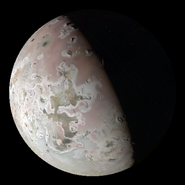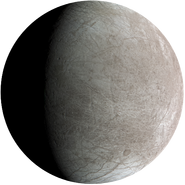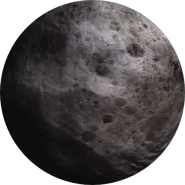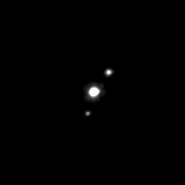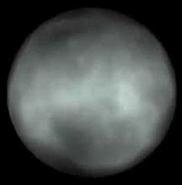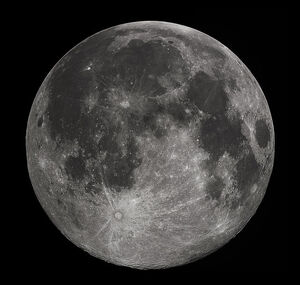
Luna, Earth's moon.
A natural satellite, commonly referred to as a moon, is a celestial body that orbits another, larger celestial body, which is called its primary, parent or partner. Natural satellites can come from a stray celestial body that gets pulled into a planet's gravitational pull or is formed from the debris of the primary shot into space by an external celestial object. There are 285 known natural satellites belonging to major planets in the Solar System as of 2023, each grouped unevenly throughout the eight planets. The Galilean moons are the largest moons of the Solar System, belonging to the planet of Jupiter, and were all discovered by Galileo Galilei and the less credited Simon Marius.
Some moons have gained enough mass to shape itself into a shape resembling hydrostatic equilibrium, or a nearly round shape. Saturn, in fact, has moons, such as Titan, and Jupiter's four Galilean moons: Ganymede, Io, Europa, and Callisto have all maintained hydrostatic equilibrium. There is no direct signs of life, though there have been traces of water discovered sandwiched between two or more layers.
Formation
Moons can be formed in many different ways. Some may be a result from a large collision, and others could be captured as a result of flying too close to the parent object. Mercury and Venus have no moons due to their close distance to the sun. Earth created its own moon. During the late heavy bombardment period, a time of volcanic activity and numerous asteroid collisions on Earth, a Mars-sized planet named Theia collided with the Earth. This resulted in tons of debris ejected from the planet, creating both the Earth's moon and the atmosphere. Mars' two moons', Phobos and Deimos, creations are theoretical. One theory supports that Mars too once suffered a bombardment period and was impacted with a generous-sized celestial body similar to Earth's. The other one supports that, because of its distance from the Asteroid belt is so close, it pulled the two moons into Mars' gravitational pull, despite it being weaker than Earth's.
The outer planets moons possibly came from the Asteroid belt, which is the most reasonable explanation for the amount of moons that the gas giants possess, outnumbering the amount of moons belonging to the inner planets, which is three, by astounding amounts. Other reasonable theories support that moons collide with other moons and created moons in the process. This causes shrinking of moons, but moons can also grow in this process. By colliding, some moons created tension and seal together due to heat, similar to the activity in the Asteroid belt.
Additional Moons
Unnamed (Provisional) Moons
Do note that this page/section is under construction, and that some information is currently not present.
You can help The Solar System Wiki by rewriting or finishing it.
Moons that have not recieved official designations are given a provisional designation. This is formed from a multitude of factors. The provisional designation of the moon S/2003 J 16 can be broken down like this:
S/ - Indicates the object is a natural satellite.
2003 - Indicates the year of discovery.
J - The prefix for satellites belonging to the Planet Jupiter (So if its a moon of Jupiter, its a J, an S for Saturn, a U for Uranus and so on)
16 - How many satellites have been discovered in the year of discovery (in this case, 1).
In full, the designation reads the sixteenth natural satellite of Jupiter discovered in 2003.
The Rings of Saturn
The Rings of Saturn contain large pieces of rock and ice crystals, some nearly the size of the Earth's moon. If astronomers, gave the major-sized rock chunks even just provisional names, it would add one hundred fifty moons to the number of satellites in the Solar System. However, the definition states that they must orbit a celestial body or planet, yet the rock chunks have not been tracked enough to establish a distinct orbit around Saturn, therefore, they cannot, at this point, be classified as moons.
The Belts of the Solar System
The Asteroid belt harnesses large celestial bodies such as asteroids, and even one minor planet. It is also home to some provisional moons, yet the only named moons of this belt have all found housing in the Solar System's largest planets. The Kuiper belt is home to the main supply of the Solar System's provisional moons and even two dwarf planets (Pluto and Eris). Pluto is actually the landlord for six moons. Charon, the largest, orbit so far from Pluto, because of its weak gravitational pull. The six moons, and Pluto, are known as Trans-Neptunian objects, objects the surpass the distance of Neptune.
Some asteroids in the Asteroid Belt have grasped moons into a gravitational pull. Ida, one of the largest irregular asteroids, grasps a moon known as Dactyl, being just barely a mile in diameter though.
Orbital Causes
Tidal Heating
Tidal heating is the interlocking of a primary, or planet, and a satellite. These celestial bodies become locked when friction between the planet and the satellite cause the ocean sandwiched beneath the layers of the moon to flex in a process known as tidal flexing. This flexing causes eruptions of the planet's surface. The interlocking only causes one side of a moon to face planet. Earth's Moon is tidally locked to us, which causes tides.
Galilean Moons
Main Article: Galilean Moons
The Galilean moons are the largest moons in the Solar System. They are some of the only moons in the Solar System, excluding Saturn's moon, Titan and a few others, to maintain hydrostatic equilibrium. They are believed to possess life due to them having oceans sandwiched between layers. This group is also home to the largest moon in the Solar System, Ganymede.
Dwarf Planet Moons
4 out of the 5 dwarf planets have one or more moons. Pluto has Charon, Hydra, Nix, Kerberos, and Styx, Haumea has Namaka and Hi’iaka, Makemake has nicknamed MK2, and Eris has Dysnomia. Some dwarf planet candidates also have moons as well.
List of Moons
Mercury
Mercury has no moons.
Venus
Venus has no moons.
Earth
- Luna (Also known as Moon or The Moon or Earth I)
Mars
Jupiter
- Adrastea
- Aitne
- Amalthea
- Ananke
- Aoede
- Arche
- Autonoe
- Callirrhoe
- Callisto
- Carme
- Carpo
- Chaldene
- Cyllene
- Dia
- Eirene
- Elara
- Erinome
- Ersa
- Euanthe
- Eukelade
- Eupheme
- Euporie
- Europa
- Ganymede
- Io
Saturn
- Aegaeon
- Aegir
- Albiorix
- Alvaldi
- Albiorix
- Angrboda
- Anthe
- Atlas
- Bebhionn
- Beli
- Bergelmir
- Bestla
- Calypso
- Daphnis
- Dione
- Eggther
- Enceladus
- Epimetheus
- Mimas
- Pan
- Pandora
- Prometheus
- Rhea
- Titan
- Telesto


